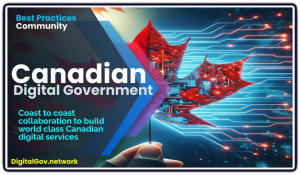 Canada defines their Digital Government strategy and ambitions here, where they believe digital innovations will deliver better services to citizens.
Canada defines their Digital Government strategy and ambitions here, where they believe digital innovations will deliver better services to citizens.
They describe their digital policy ambitions in detail in this guide, where the Treasury Board Minister and CIO preface a detailed strategy and ambition for digital technologies in Canadian Government.
In this podcast Public Spark explore this policy and DTiG also shares an interview with CIO Catherine Luelo who explains more, with accompanying slides (pdf download).
Canadian Digital Government – There’s An App for That
For some background context to this policy in his inspiring 2019 TEDx talk Scott Brison described how the Canadian government needs to apply the capabilities of the digital native leaders, like Netflix and Amazon, to the principles of Digital Government.
 He highlights how these innovators have adapted rapidly to the new digital world and deliver online services that are so simple and intuitive his four year old children can quite happily navigate them via an iPad. But yet online governments still struggle to achieve this same streamlined ease of use.
He highlights how these innovators have adapted rapidly to the new digital world and deliver online services that are so simple and intuitive his four year old children can quite happily navigate them via an iPad. But yet online governments still struggle to achieve this same streamlined ease of use.
“We can’t be a Blockbuster government serving a Netflix citizenry”
The principle change is in how government IT is built – Moving from slow, waterfall methods to an agile, work-in-the-open approach, where releases are delivered quickly and iteratively to users to ensure the goal of user-friendly systems is being met in real-time.
An updated version of this philosophy is articulated by Senator Colin Deacon in this podcast: Moving from Analog to Digital Government.
Coast to Coast Collaboration
The essence of the people that make up the sector and how they work together is conveyed through this interview from DigitalBC. Across local and federal Governments and across the country Canadians work together hand in hand to help one another achieve their digital strategy goals.
Join a conversation on the important role played by inter-provincial cooperation on all things digital and cybersecurity between CJ Ritchie, British Columbia’s Government Chief Information Officer, and Natasha Clarke, Nova Scotia’s Deputy Minister of the newly created Department of Cyber Security and Digital Solutions.
This is a unique opportunity to witness two colleagues located on opposite ends of Canada (4,615 KM apart, to be exact) yet united in their efforts to bring about change in the digital era. From behind-the-scenes insights into pan-Canadian decision-making and everything in between.
In the same vein Canada also takes steps to share their work as open source as much as possible. A key technique for accelerating progress is for agencies to openly share the innovations and best practices they develop, so that other agencies can learn from and emulate them. For example key resources include the Web Experience Toolkit, available via a Github repo.
Shared Services Canada
One of the flagship Digital Transformation programs is Shared Services Canada (SSC), detailed in this analysis video.
The creation of SSC was a transformative event for the Government of Canada’s IT landscape, given an ambitious mandate to modernize and consolidate the GC’s IT infrastructure. Today, 7,100 SSC employees support the technology needs of over 200,000 federal public servants and handle about 600,000 requests and 100,000 incidents per year.
SSC takes an enterprise approach that builds upon other GC programs such as the Cloud First Adoption Strategy, and the Directive on Automated Decision-Making for the responsible use of artificial intelligence. A decade later, SSC has steadily marched towards its goal of building modern, reliable, and secure digital platforms that meet the needs of Canadians, today and tomorrow.
Government as a Platform
The ultimate vision for Canadian Digital Government is to realize a “OneGC”, an ability to provide any service on any platform or device and through any trusted partner, achieved through a strategy known as ‘Government as a Platform’.
“a Digital Exchange Platform is being established to help enable government departments to authenticate data with each other and the outside world in a modern, secure, and unified way in an effort to deliver secure private services in a digital age.”
In this Treasury Board presentation and this OMG keynote talk, the CDXP lead Teresa D’Andrea, Director for Interoperability, provides an overview of the program, where core ethos and vision of GaaP is that every service should be accessible and consumable via an API, with the CDXP providing the enabling mechanisms of API interfaces, messaging and bulk data transfers.
The CDXP enables secure, private, real time information sharing with privacy and security “baked in”, allowing systems within and outside of government to connect and function in harmony to support digital service delivery to citizens and businesses.
Digital Identity
A keystone foundation of this platform approach is Digital Identity, and Canada offers an exemplar blueprint for a holistic, national approach to Digital Identity. In their blog ‘Why Canada Needs a Digital ID Framework‘ DIACC describes a compelling argument for accelerating the development and adoption of a Canadian digital identity system, and has developed a standards program for building this out, the PCTF: Pan-Canadian Trust Framework.
In this video Tim Bouma Senior Policy Analyst Identity Management for the Canadian Government, shares an overview, explaining that the Canadian Government’s Identity strategy has been under development for over a decade, evolving from a program to a user to now a Self Sovereign view for Digital Identity, and that is an ongoing process of innovation, with key goals of a pan-Canadian, technology-agnostic model.
Canadian GovCloud
Canada’s strategy for Cloud adoption is detailed in this policy guide for Application Hosting, and the Public Spark team explain it in more detail in this podcast, covering cloud-first approaches, data residency, and how these changes will affect public servants.
Watch Jaimie Boyd, Deloitte’s National Digital Government leader, as she explains why the cloud is a powerful catalyst for modern government services, and read more in their report: ‘Capitalizing on government’s cloud momentum – How to accelerate mission-critical outcomes in the Canadian public sector’.



